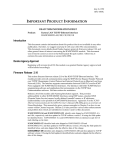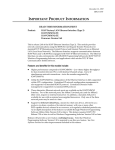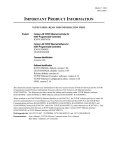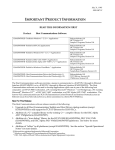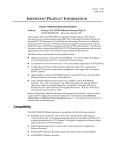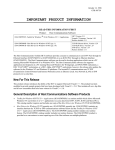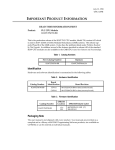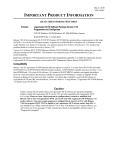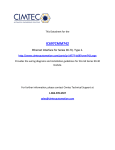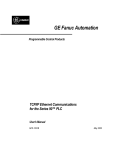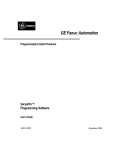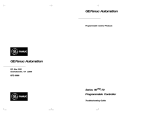Download datasheets/03/Series_90-70/90-70 Product Updates/Series 90
Transcript
January 29, 1999 GFK-1314J IMPORTANT PRODUCT INFORMATION READ THIS INFORMATION FIRST Product: IC697 Factory LAN Ethernet Interface (Type 2) IC697CMM742-FG Firmware Version 2.80 This is a maintenance release of the IC697 Ethernet Interface (Type 2). This module provides network communications using the SRTP (Service Request Transfer Protocol) and Ethernet Global Data over standard TCP/IP (Transmission Control Protocol and Internet Protocol) on an Ethernet LAN (Local Area Network). The Ethernet Interface supports communications between IC697 PLCs and/or IC693 PLCs equipped with TCP/IP Ethernet Interfaces. The Ethernet Interface can also communicate with MS-DOS®-Based Programming Software for IC697 TCP/IP, Windows®-Based Programming Software, and applications that use the TCP/IP Host Communication Toolkit software. Features and Benefits Features and benefits for this module include: Higher performance compared to IC697CMM741—2 to 4 times higher throughput for data transfers between PLCs with identical Channel setups. Up to 32 simultaneous network connections—twice the number supported by IC697CMM741. Unlike the IC697CMM741, configuration of the Ethernet Interface is fully supported within CPU configuration. Centralized IP network configuration management is also supported via standard BOOTP protocol. Centralized Domain Name management is supported via standard DNS protocol. Three alternative Ethernet network ports are available on the IC697CMM742 Interface. Two of the network ports, the 10BaseT (twisted pair) and the 10Base2 (thin wire), require no external transceiver. In addition, a standard AUI port is available for use with an external user-supplied transceiver. Only one of the three network ports may be used at a time. New Features This maintenance release incorporates the following improvements: 1. An improved method for handling backplane mail between the CPU and Ethernet Interface, improving overall Ethernet Interface performance – especially in PLC systems with long sweep times. 2. Inclusion of the WinLoader update utility into the field upgrade kit. 3. Resolution of several problems. Refer to the section "Problems Corrected in This Release (2.80) ®Windows and MS-DOS are registered trademarks of Microsoft Corporation. Important Product Information: IC697 Factory LAN Ethernet Interface (Type 2) 2 GFK-1314J Functional Compatibility The IC697CMM742 Interface is compatible with the following products: IC697 CPU models CPU781, CPU782, CPM914, CPM915, CPM924, and CPM925 loaded with firmware versions 6.00 or higher. IC697 CPU models CPX772, CPX782, CPX928, and CPX935 loaded with firmware versions 7.80 or higher. IC697 CPU model CGR935 loaded with firmware version 7.50 or higher. IC697 CPU model CGR772 loaded with firmware version 7.85 or higher. Limited Server-mode only operation is possible with older CPU models (CPU731/732, CPU771/772: 4.12; CPU780: 4.60). Note: Do not attempt to perform any firmware upgrade of an IC697CMM742 Interface while it is installed in one of these older CPU systems. The operation will fail. Move the Interface to a CPU system running Release 6.00 or higher to perform the download. For some features, more recent CPU releases are required: Ethernet Global Data: Name Resolution: SNTP timestamping of EGD: Release 7.20 or higher Release 7.00 or higher Release 7.80 or higher (Release 7.50 or higher for Redundancy systems) IC697 Ethernet Interface IC697CMM741 loaded with TCP/IP software IC651ENS042. IC693 Ethernet Interface IC693CMM321 MS-DOS-Based Programming Software version 6.02 or higher (required to configure the Ethernet Interface). For some features, Windows-Based Programming Software is required (see below). Windows-Based Programming Software Version 1.00 or higher. For some features, higher versions are required: Ethernet Global Data: SNTP timestamping of EGD: Name Resolution: Multiple Gateways: Version 2.00 or higher Version 2.10 or higher Version 2.00 or higher Version 2.10 or higher Host Communications Toolkit (HCT) software products listed below.* Toolkit for Windows NT/95 C/C++ Applications (IC641SWP058) Toolkit for Windows 3.xx C/C++ Applications (IC641SWP052) Toolkit for HP-UX C Applications (IC641SWP054) Toolkit for DEC VAX/VMS C Applications (IC641SWP053) Toolkit for DEC Alpha AXP/VMS C/C++ Applications (IC641SWP057) Host Communication Drivers for Windows NT/95 (IC641SWP080, IC641SWP081) Host Communication Drivers for Windows (IC641SWP050, IC641SWP051) * Some versions of HCT do not support the ‘Send Information Report’ COMMREQ or Ethernet Global Data. At the time of this publication, only the Windows NT version of HCT can consume Ethernet Global Data exchanges. Please refer to the appropriate HCT IPI document for more information. Important Product Information: IC697 Factory LAN Ethernet Interface (Type 2) 3 GFK-1314J Hardware Identification EX7A1: 44A737150-G01 R08 Field Update Kit 44A739337-G05 Data Sheet GFK-1309E User Manuals TCP/IP Ethernet Communications for the IC69* PLC User’s Manual TCP/IP Ethernet Communications for the IC69* PLC Station Manager Manual Operational Notes Network Bandwidth Utilization Due to its performance potential, the IC697CMM742 Interface can present a heavy load on the network segment at its maximum operating capacity. Both Ethernet Global Data and Channel operation can contribute to an extremely high rate of network traffic when even a few such modules are involved. The potentially high network bandwidth utilization can cause a higher-than-normal rate of network collisions which may cause timeouts on data transfers. By configuring transfer timing to no more than you need, you can minimize such problems. For Ethernet Global Data operation, it is strongly recommended that caution be taken when defining exchange parameters. In particular, period values should be set to the required rates for your particular application instead of ‘as fast as possible’ rates. For Channel operation, it is strongly recommended that caution be taken when using multiple connections operating in an ‘as fast as possible’ mode. Tests conducted at the factory showed that 32 simultaneous Channels transferring 2 Kilobytes of data per Channel between two IC697CMM742’s can use up as much as 18% of the total network bandwidth when the Channels are all configured to run ‘as fast as possible’ using CPM91x or CPM92x CPUs. Network administrators consider 30% the threshold of Ethernet network overload. If your application requires many simultaneous network connections between IC697CMM742 Interfaces, it is recommended that the “read period”, “write period”, and “transfer period” used in COMMREQs be set to the required rate for your particular application instead of “as fast as possible”. This will reduce the risk of overloading the network with traffic to and from the IC697CMM742 Interface. CPU Performance Limitation Again, due to its performance potential, the IC697CMM742 Interface can present a heavy load on the CPU at its maximum operating capacity. It is strongly recommended that caution be taken when using multiple connections operating in an “as fast as possible’” mode especially when a model CPU781 or CPU782 CPU is used. The COMMREQ Status Word (CRS Word) may occasionally become FE07 or FE87, which means service requests are made to the CPU faster than the CPU can process them. Although communications will proceed to the next repetition even when this is encountered, data transfer for the current repetition of this connection would have failed to complete. Important Product Information: IC697 Factory LAN Ethernet Interface (Type 2) 4 GFK-1314J To avoid this situation, configure the, “read period”, “write period”, or “transfer period”to a larger value so the CPU has enough time to process all service requests. Also, issuing a large number of COMMREQs to one Interface in one sweep may result in temporary resource exhaustion within the CPU, the Ethernet Interface, or both. If this occurs, the PLC logs a fault in the PLC fault table with fault group of “Option Module Software Failure” and error code equal 2 indicating that the COMMREQ frequency is too high. When this occurs, the ”FT” output of the COMMREQ function block will also be set. It is recommended to use logic that staggers the execution of COMMREQs across multiple sweeps so that a limited number of COMMREQs (typically 8 or less) are sent to a given board in each sweep. In addition, the FT output parameter should be checked for errors. If the FT output is set (meaning an error has been detected), the CommReq can be re-issued by the application logic. Additionally, avoid operations that cause the watchdog timer to expire. We recommend configuring the System Communications Window mode for “Limited” operation. The value of the System Communications Window timer is application dependent, but a typical value is between 50 and 100 milliseconds. Also, the watchdog timer value should be configured to be slightly larger than the sum of the System Communications Window timer and the maximum anticipated scan time. Use of Windows-Based Programming Software “Store” Function When performing a Store to PLC operation from Windows-Based Programming Software Version 2.0 to a PLC system that contains an IC697CMM742 Interface. we make the following important operational recommendation regarding the Hardware Config components that appear within the Folder tab: Every Hardware Config component that appears in the Store dialog must always be selected when performing a Store operation. Failure to follow this recommendation may result in unexpected operation of Ethernet Global Data and Name Resolution features. (Note: this guideline does not apply to Store operations that include only Global Vars and/or Resource, which are not Hardware Config components.) No Fault Table Entry if CMM742 Fails If, due to hardware failure or other catastrophic condition the CMM742 ceases operation (colloquially referred to as "lights out"), a Loss of Module fault is not recorded in the PLC Fault Table. Also, the Exchange status word for any produced Ethernet Global Data exchange does not become "18” indicating the loss of the Ethernet Interface. A logic program can monitor the health of a CMM742 by examining the LAN Interface OK bit (Status Bit 16) within the LAN Interface Status bits. This bit is 1 during normal operation, and will become 0 if the Interface experiences catastrophic failure. AUI Cable Removal Power to the PLC must be turned off whenever the transceiver cable (AUI cable) is connected or disconnected at the IC697CMM742 Interface AUI port or at the transceiver. SQE Enable If the AUI network port is used, the IC697CMM742 Interface requires that the SQE test be enabled on the external transceiver connecting it to the Ethernet LAN. Make sure your transceiver has SQE enabled. Otherwise, the Ethernet Interface will not go online and will log a “LAN Severe Network Problem; Attempting Recovery” fault. Important Product Information: IC697 Factory LAN Ethernet Interface (Type 2) 5 GFK-1314J PLC Power Supply Requirements If the AUI network port is used, the IC697CMM742 Interface requires that the PLC include a power supply which supplies ±12Vdc (IC697PWR711/721/724/731/748). (Note: If an externally powered transceiver is used on the AUI network port, ±12Vdc is not required but an erroneous ‘blown fuse’ fault will appear in the CPU fault table.) Ethernet Interface PLC Installation Restrictions The IC697CMM742 Interface must not be installed in the main IC697 PLC rack. The Ethernet Interface will not function properly if placed in an expansion rack. There may be no more than four (4) LAN Interfaces in a single PLC. This limit applies to the total number of IC697CMM721, IC697CMM731, IC697CMM741, IC697BEM741, and IC697CMM742 boards in the PLC. Special Note on Operation with Earlier PLC CPUs (Point Faults Enabled) When the following set of conditions is true, the PLC CPU may report a page fault and cease to operate: CPU firmware revision is earlier than 7.00. Point faults are enabled. An Ethernet Interface is configured and its Status Address located in non-discrete memory (for example: %R). A “Loss of Module” or “System Configuration Mismatch” fault is logged when the configuration is stored or upon powerup. We recommend that the Status address be located in discrete memory if point faults are enabled in a PLC system running a CPU firmware revision earlier that 7.00. Special Note on Operation with Earlier PLC CPUs (%P and %L Memory) When your ladder program accesses %P and %L memories through COMMREQs, and a Release 6.00 CPU is used on the server PLC, the COMMREQ Status Word (CRS Word) may occasionally return F405. If this occurs, temporary relief may be obtained by cycling power on the server PLC. Permanent relief requires a CPU firmware upgrade to 6.02 or greater on the server PLC. Managing Channels and TCP Connections In certain conditions TCP connections can be totally consumed. When you issue a COMMREQ to establish a read or write channel, a TCP connection is created, the transfer(s) are made, then upon completion of all the transfers, the TCP connection is terminated. If an application is constructed so that it rapidly and repeatedly establishes a channel with only one repetition (one transfer), the available TCP connections for the Ethernet Interface may be totally consumed. Specifically, if your ladder program for issuing COMMREQs is constructed so it does the following, all available TCP connections can quickly be used up. The number of repetitions (Word 9 in an Establish Read or Write Channel COMMREQ) is set to 1 and a new COMMREQ is issued repeatedly and immediately upon completion of the prior one. Use “channel re-tasking” to avoid using up TCP connections. Re-tasking is described in Chapter 3, “Programming Communications Requests”, in the TCP/IP Ethernet Communications for the IC69* PLC User’s Manual. Important Product Information: IC697 Factory LAN Ethernet Interface (Type 2) 6 GFK-1314J Some PLC Fault Table Entries are Imprecise In the PLC Fault Table display of the IC641 Programming software, the following messages may not provide a meaningful description of the problem for the Ethernet Interface: “LAN PROM/software mismatch; running soft Sw util” “LAN system-software fault; resuming” “LAN Severe Network Problem; Attempting Recovery” “Module software corrupted; requesting reload” Should you see these messages, select the message and enter F10 (ZOOM) or CTRL+F to display the error codes associated with the message. Then refer to Appendix B: “Exception Log Event Description”, in the TCP/IP Ethernet Communications for the IC69* PLC Station Manager Manual, for an accurate explanation of the error codes. Important Product Information: IC697 Factory LAN Ethernet Interface (Type 2) 7 GFK-1314J Problems Corrected in This Release (2.80) ID Code Description CR62260, CR66101 Timely processing of SRTP and Ethernet Global Data requests may be impacted by PLC sweep times greater than 100 ms. CR67607 When the Ethernet Interface is used with a PLC CPU earlier than Release 6, the node command indicates that "“PLC CPU Version 6.00 or higher is required for full operation.” This is not completely accurate, as many recent features require PLC CPU versions higher than 6.00. An SRTP Channel will now be properly retasked while in the AWAIT_DRSP or AWAIT_CRSP states. CR67962 CR68276, CR68278, CR68359 Handling of 3 types of network errors has been improved under temporary heavy network load conditions. Error Condition Recorded as MAC Tally LLC Exception Log Type Lost Carrier LostCarr entry 2 = 102H Maximum Retries Exceeded FRtry entry 2 = 10Ah Late Collision LateColl entry 2 = 10bH For all these errors, the LLC will tolerate up to four consecutive occurrences of an error before restarting the LLC. During an LLC restart, the Ethernet Interface cannot communicate on the network, so fewer LLC restarts result in less disruption to communications. Also, the Maximum Retries Exceeded condition is now logged in the Ethernet Interface’s exception log and the PLC’s fault table only after a fourth consecutive occurrence, thus reducing nuisance fault reports. Important Product Information: IC697 Factory LAN Ethernet Interface (Type 2) 8 GFK-1314J Restrictions and Significant Open Problems Open Problems in Release 2.80 Firmware ID Code Description CR54556 The IC697CMM742 Interface can not communicate with the local PLC CPU when a PLC load or a store operation is in progress. A PLC load or store operation (via MS-DOS-based programmer WSI, Serial, and/or Ethernet or Windows-based programmer either serial or Ethernet) has priority over all other communications. During a PLC load or store operation, it is possible for channels or server connections to experience time out errors, which may lead to disconnections. Possible exception log entries include log event 8, entry 2 = 8, 38, or 40. Whenever these backplane errors are logged, there are likely to also be additional exception logs for terminated TCP connections and SRTP Server and Channel API errors. Application programs should always be written to detect and recover from time out conditions. CR63808 Under very heavy Channel load conditions, LAN system software faults are intermittently reported. The reported exception log entry is log event 8, entry 2 = 39, entry 3 = fff5. This has been observed in an application with 32 Write Channels of 1024 bytes each, updating and “retasking” as quickly as possible. Channel operation continues without errors. CR64052 While a local Station Manager “TRACE LZ” troubleshooting command is in effect at an Ethernet Interface, do not issue Station Manager “REM <node> TEST” commands to it from a remote Interface. Doing so can cause errant behavior, including module lockup and loss-of-module in the PLC fault table. CR68750 While performing a firmware update, do not attempt to connect to the Ethernet Interface using a serial data rate lower than the Interface’s configured S/W Load data rate (default = 19,200 bps). Doing so will cause the Interface to halt (“lights out”). If this occurs, press the restart button to recover the Interface, then reinitiate the firmware update. CR68756 When performing a firmware update, always use the serial cable assembly IC690ACC901 as recommended in the user documentation. Use of other cables, especially very long cables, may inhibit the Firmware Update Utility program from successfully communicating with the Ethernet Interface CR68886 Under extremely heavy loading conditions, the Ethernet Interface time of day clock will gradually fall behind. (This condition is unlikely to be seen in field applications.) CR69003 Do not attempt to ping the Ethernet Interface from a computer specifying more than 32739 data bytes in the ping message. Doing so may cause the Ethernet Interface to cease communications for several minutes before resuming normal behavior. CR69160 Under a moderately heavy SRTP traffic load, the Ethernet Interface may lose synchronization with its SNTP time server. An example of SRTP traffic load which does not adversely impact SNTP synchronization is servicing 4 (incoming) Channels, each running As Fast As Possible and transferring 2048 bytes of data. Important Product Information: IC697 Factory LAN Ethernet Interface (Type 2) GFK-1314J Changes and Additions to the TCP/IP Ethernet Communications User’s Manual PC Software Loader (Appendix C) The contents of the Appendix will be replaced with new instructions that add information about how to use the WinLoader utility to perform a firmware load. These new instructions (44A747185) are included with the firmware update kit (44A739337-G05). Software Loader (Appendix D) At the time of this publication, it is not possible to perform a firmware load to the IC697 Ethernet Interface (Type 2) while it is operating with an IC697 PLC CPU running firmware version 4.12 through 5.50. Do not attempt to do so - the operation will fail. Move the Interface to a IC697 PLC CPU system running Release 6.00 or higher to perform the firmware load. Changes and Additions to the Station Manager User's Manual Exception Log Event Descriptions (Appendix B) For Log Event Code “1”, the following additional values for Entry 3 are possible: 2 Load request through pushbutton 4 Station Manager load request 6 Automatic load due to system error (see preceding log event 2) b Load request due to corrupted primary software For Log Event Code “C”, parenthetical note within the description of Entry 2 = 10aH should read “(This report may also occur under normal network operation if your network has hundreds of nodes or is exceptionally busy. In this case, operation continues but the transmitted message is lost. If this occurs too often, you may need to redesign your network to limit collisions.) Tally Descriptions (Appendix C) In Table C-6 “ICMP Tallies”, the tally “Filtered” should be described as: Filtered Number of ICMP messages ignored because they are not directly addressed to this node, or because this node has detected an invalid source address for an incoming IP or ICMP message. 9









